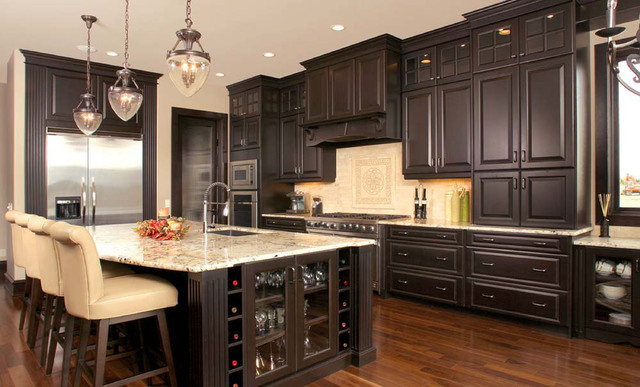Staining cabinets creates new look
You may not need to replace those kitchen or bathroom cabinets, nor the built-ins in your living room or den. All it takes to create the look of newness and perhaps eliminate that outdated light color of your cabinets is staining those wood structures, drawers and doors.
When you start looking at stain colors, it’s easy to get overwhelmed. The hues are just so lovely, and some seem so similar in tone, that you may find yourself stumped to such a degree that you can’t even decide between light and dark wood stain.
To help you choose a stain color for your cabinetry, here are some tips to keep in mind:
n Test colors against your existing hardwood floor color. The shade of your cabinet stain shouldn’t match exactly. You need some color contrast to allow the beautiful finish of your cabinets to stand out.
A coordinating shade is ideal. It’s a common error among home remodelers to forget to place stain color samples against their existing flooring and even ceiling colors.
n Think about how light, medium and dark stains perform with your room’s theme and style. Lighter stains can, of course, brighten casual spaces and go well with a country-themed room.
Medium stains such as chestnut suit more traditional decor in your room’s design, adding richness and warmth while easily complementing many different types of wood in your home. And medium stains can extend beyond wood colors to exotic hues such as pink and green for a more whimsical or even spa-inspired color design.
Dark stains such as ebony and mahogany create a rich, stylish look for a room, complementing modern interiors. Dark stain is a top trend now, complementing nonwood pieces such as a clawfoot tub or pedestal sinks whose colors “pop” alongside darker custom cabinetry.
n Consider your wood species. According to the experts at The Furniture Guild, “the species of wood you selected for your … custom cabinetry will greatly affect your selection of wood stain color.”
Oak is considered the easiest wood to stain and gives you the greatest amount of color options. Cabinetry (and wood flooring) made of maple, birch and coniferous wood such as pine or fir are difficult to stain evenly and look best when left in their natural hues.
It’s a factor to consider, since some of these woods come in a more limited number of shades. Talk to your paint store expert to get helpful lessons in different woods’ grain sizes and pores to understand better what goes into your staining process and color choice.
n Explore classic and exotic wood stains. For instance, basic wood stain colors may be oak or pine, and you’ll also find exotic wood stain colors such as black forest bamboo, caramel bamboo, ebony, rosewood, wenge and a striped effect called zebrawood, among other shades suitable for different wood types.
n Think about lighting and traffic. Lighter-colored stains will generally show the wood’s knots and whorls, and any dust or pet hairs on your cabinetry won’t be as visible as they would on darker stain. Even scratches on your cabinets can be less evident. Darker stains will camouflage wood’s natural imperfections or make knots less visible, but scratches, dust and pet hair will be more visible.
n Complement the other wood tones and design details in your home. If you already have wood furniture in the room, you’ll want to select a wood stain color that complements your existing piece.
Keep in mind that the wood flooring leading from your bedroom or hallway and leading into your bathroom will play a big role in helping you select your cabinetry wood stain colors, so that the shades and tones leading into your bathroom create a beautiful flow of hues and wood details.
n Decide between water-based and oil-based color stains. The experts at DIY Network say, “There are several advantages to using water-based color stains. For one thing, they offer a range and intensity of colors that oil-based stains can’t begin to offer. For another, they can be used without the need for ventilation, since they produce no dangerous fumes, and cleanup is simple — just soap and water.”
n The DIY Network experts say, “Stains add color but don’t protect wood, so some type of sealant must be used. Don’t use polyurethane, though: It always adds a slight yellow tint. Instead, use a water-based finish, which can be applied with either a brush or an aerosol spray.”
n To help you get started considering wood finishes for your custom bathroom remodel, review the Furniture Guild’s helpful chart: http://thefurnitureguild.com/#finishes. Or visit your favorite paint retailer’s website to view their stain color charts, which may be interactive on their site to “try out” wood stain shades on a photo of your room.

















